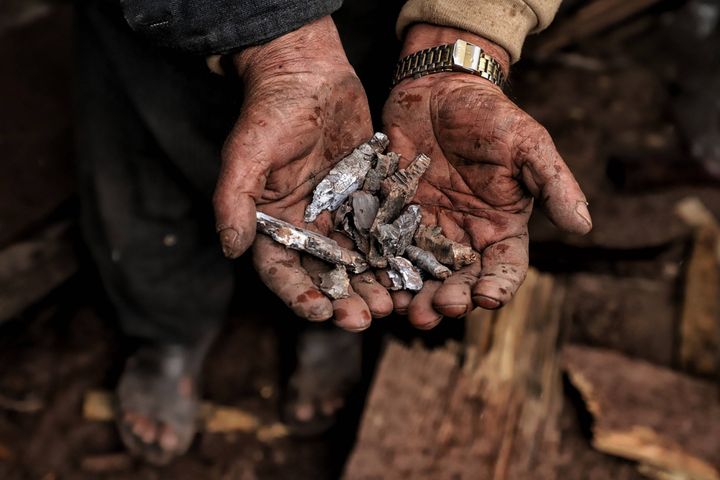
URI, Jammu and Kashmir - Farooq Ahmad was at home when he heard exploding shells fired from across the Line of Control (LoC) in Kashmir. With no bunkers for people to hide in his village, Ahmad told his five children not to leave the house. This was at around 11:30 am on Friday, 13 November. Two hours later, at around 1:00 pm, a mortar shell fell inside his house, killing his wife, Farooqa Begum.
When HuffPost India spoke with Ahmad on Saturday in Balkote village in the Uri sector of Baramulla district, the 36-year-old labourer said that he waited for seven hours for the shelling to stop before he could bury his wife.
Ahmad said he couldn’t face his young children, who were asking for their mother.
“My wife was looking after these children. I don’t know what to do now,” he said, sitting amid the remains of mortar shells outside his house. “No one visited us to provide any relief. We have been left at the mercy of God.”
At least six civilians, including a seven-year-old boy, and five Indian soldiers were killed in the deadly exchange of fire between India and Pakistan on Friday. The Hindu reported that over 20 people had been injured.
The Indian Army said that “Pakistan deliberately targeted civilian areas” in an “unprovoked ceasefire violation.” The Indian Army said that “six to eight” Pakistani soldiers were killed in retaliatory fire.
Both sides have violated the 2003 Ceasefire Agreement that was key to life returning to the villages near the LoC.
Pakistan said that India had committed over 1,300 ceasefire violations in 2017, killing 52 of its nationals. India said that Pakistan had violated the ceasefire 860 times in 2017. The number of ceasefire violations by Pakistan along the LoC doubled to 3,200 in 2019, compared to 1,629 violations recorded in 2018, The Print reported, citing Indian government data. The data showed a spike in ceasefire violations after the Narendra Modi government ordered airstrikes inside Pakistan in February, 2019, days after a deadly attack by a suicide bomber killed more than 40 Indian soldiers in Kashmir, A second spike in violations reportedly occurred after the Modi government revoked Jammu and Kashmir’s special status in August, 2019.
Kashmiris, who live in the villages close to the LoC, had hoped for a better future after the Ceasefire Agreement came into force in 2003. The situation seemed to get better in 2005, when Prime Minister Manmohan Singh flagged off the first bus service across the LoC to connect people divided by the conflict.
Two decades later, Kashmiris, and their small houses fronted by vegetable gardens in the mountainous region, continue bearing the brunt of the never ending cycle of India-Pakistan hostilities and one-upmanship.
Bashir Ahmad, a resident of Kamalkote village, said the conflagration on Friday was one of the deadliest he had survived.
“The shelling started at 10:30 am on Friday and continued till 9 pm. Everyone was running for safety. It seemed like doomsday,” he said.
Syed Nadir Hussain, a 36-year-old from Kamalkote village, was hit by a mortal shell and rushed to the hospital in a critical condition. Both his legs were amputated.
In village Gohalan, seven-year-old Afrar Ahmad was hit by splinters and died.
Javid Hussain from Hajipeer village returned with his family to a damaged house and dead animals.
“We did not sleep the whole night. There is massive damage to our houses and many goats and cows also got killed,” he said. “Either this shelling has to be stopped or we should be relocated from here. Nobody is concerned about us. It is Kashmiris who get killed on both sides of the border.”
While almost 8,000 bunkers to protect people during shelling have reportedly been completed along the LoC and International Border in the Jammu Division of J&K, Rs 25 crores was sanctioned for the construction of 125 community bunkers in Kashmir’s Baramulla and Kupwara districts, earlier this year, and construction is reportedly underway.
Riyaz Ahmad, Sub Divisional Magistrate of Uri, said that 40 community bunkers at the cost of Rs 20 lakh each had been sanctioned for Uri. “Once completed, these bunkers will provide a greater relief to these people, where they can take refuge during shelling,” he said.
Speaking over the phone, Bashir Ahmad, who lives in Tangdhar in Kupwara, said, “We live in constant fear as it is a warlike situation. We do not know when the shells will again start.”
In a phone conversation, Mohammad Abdullah, who lives in Gurez in Bandipora district, where two Indian soldiers died, said, “It is unfortunate when countries are fighting against Covid-19, India and Pakistan are fighting each other with guns and bombs on the LoC.”
For the latest news and more, follow HuffPost India on Twitter, Facebook, and subscribe to our newsletter.